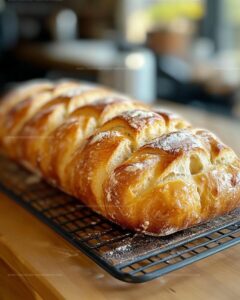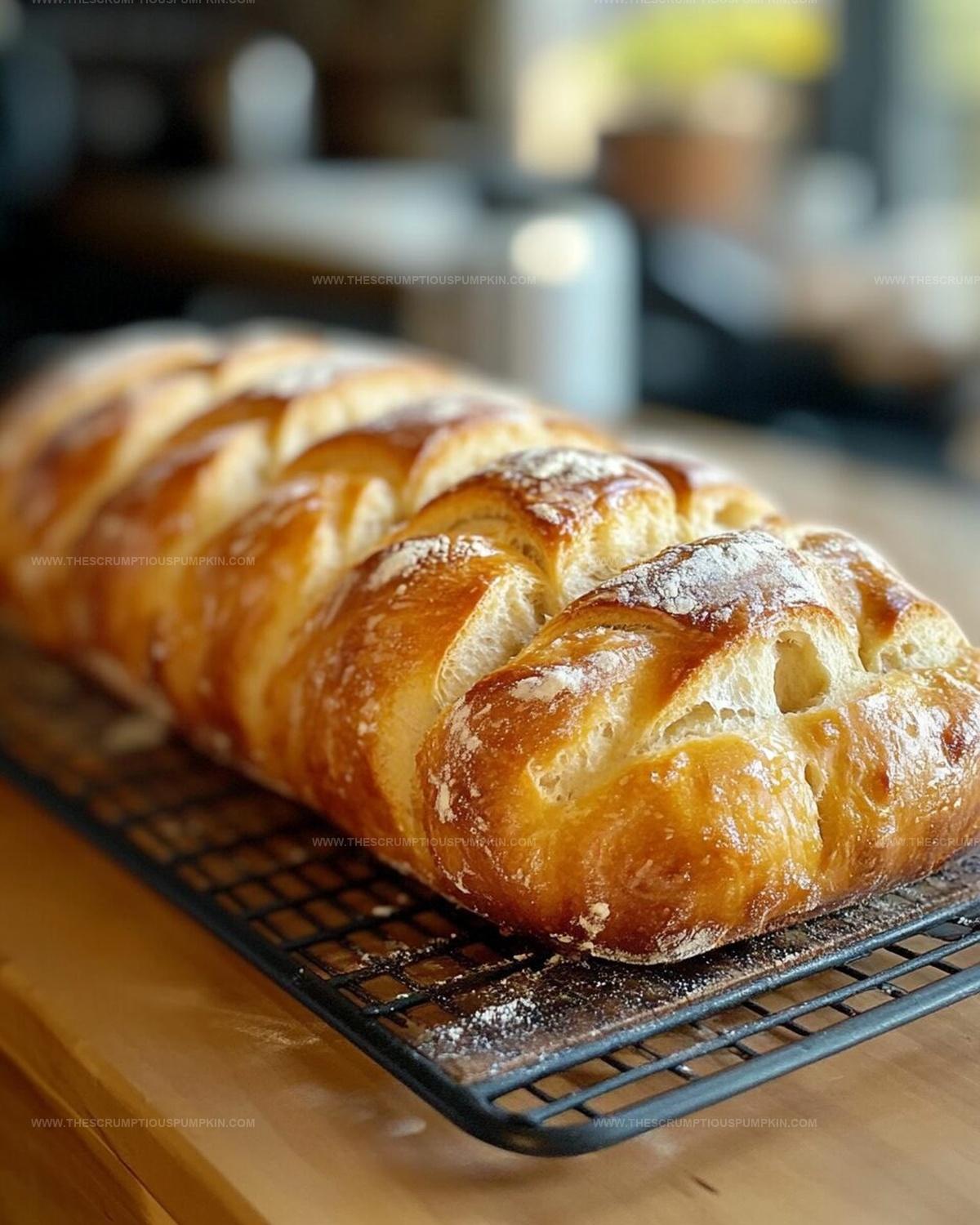Hearty Traditional German Rustic Bread Loaf Recipe for Beginners
Crafting a traditional german rustic bread loaf demands passion and patience from home bakers seeking authentic flavors.
Rough-textured and hearty, this classic recipe connects you to generations of baking wisdom passed down through German kitchens.
Wheat and rye blend perfectly to create a dense, flavorful loaf with a robust crust that crackles when sliced.
Generations of bakers have perfected techniques that make this bread more than just a side dish, it’s a culinary tradition.
Each ingredient tells a story of rural landscapes and time-honored cooking methods.
Kneading becomes a meditation, transforming simple ingredients into a masterpiece that fills your kitchen with warmth and comfort.
A slice of this bread will transport you straight to a cozy German bakery, inviting you to savor every remarkable bite.
What Makes This Rustic German Bread So Special
Core Ingredients Behind the Old-World Crust
Flour Base:Leavening and Seasoning:Liquid and Moisture Ingredients:Easy Steps to a Traditional Rustic Loaf
Step 1: Activate The Oven
Turn on the oven and set the temperature to a toasty 200°C (390°F) to prepare for your bread-baking adventure.
Step 2: Create Dry Mixture
In a spacious mixing bowl, combine your flour, dry yeast, salt, and sugar.
Whisk these ingredients together until they’re perfectly blended.
Step 3: Introduce Liquid Elements
Pour warm water and oil into the dry mixture.
Stir gently with a wooden spoon until a shaggy dough starts to form.
Step 4: Transform Dough Through Kneading
Transfer the mixture onto a lightly floured surface.
Use your hands to knead the dough, pushing and folding for 5-7 minutes until it becomes smooth, stretchy, and develops a silky texture.
Step 5: Shape Your Bread Masterpiece
Mold the dough into a rustic, rounded loaf shape.
Place it carefully on a parchment-lined baking sheet.
Step 6: Allow Dough To Rise
Cover the loaf with a clean kitchen towel.
Let it rest in a warm, draft-free spot for 30 minutes, allowing the yeast to work its magic and help the dough expand.
Step 7: Prepare For Baking
Using a sharp knife, create a few diagonal slashes across the top of the loaf.
These cuts help the bread expand and create beautiful crust patterns.
Step 8: Bake To Perfection
Slide the baking sheet into the preheated oven.
Bake for 30-35 minutes until the bread transforms into a golden-brown beauty with a crisp exterior.
Step 9: Cool And Enjoy
Remove the bread from the oven.
Let it rest for a few minutes, then tap the bottom – it should sound hollow. Slice and savor your homemade German rustic bread.
Pro Tips for Achieving the Perfect Dense Slice
German Bread Twists You’ll Want to Try
Best Food Matches for a Rustic German Slice
How to Store German Bread for Days of Goodness
Rustic Bread Questions—Let’s Clear Them Up
Bread flour or strong wheat flour with high protein content provides the best structure and chewiness for a traditional German rustic bread loaf.
Dissolve the yeast in warm water and wait 5-10 minutes. If it becomes foamy and bubbly, the yeast is good and ready to use in the recipe.
Kneading develops gluten, which gives the bread its texture and helps it rise properly, creating a light and airy interior with a crusty exterior.
Scoring creates controlled cuts on the bread’s surface that allow the dough to expand during baking and prevents uneven cracking, helping the bread rise more evenly.
Print
Traditional German Rustic Bread Loaf Recipe
- Total Time: 1 hour 10-15 minutes
- Yield: 2 1x
Description
Hearty german rustic bread loaf brings warmth from rural kitchens, connecting generations with its dense, crusty texture. Homemade comfort awaits you through simple ingredients and classic baking techniques that celebrate authentic German culinary heritage.
Ingredients
Main Ingredients:
- 500 grams (17.6 ounces) all-purpose flour
- 300 milliliters (10.1 fluid ounces) warm water
- 50 milliliters (1.7 fluid ounces) vegetable oil
Leavening and Seasoning:
- 1 packet (7 grams / 0.25 ounces) dry yeast
- 1 teaspoon salt
- 1 tablespoon sugar
Instructions
- Activate the oven to 200°C (390°F) for optimal baking temperature.
- Blend dry ingredients – flour, yeast, salt, and sugar – in a spacious mixing vessel, ensuring uniform distribution.
- Introduce warm water and oil into the dry mixture, stirring until a cohesive dough forms.
- Transfer dough to a lightly floured surface and knead vigorously for 5-7 minutes, developing gluten and creating a smooth, elastic texture.
- Mold the dough into a rustic loaf shape, positioning it centrally on a prepared baking sheet.
- Drape a clean kitchen towel over the dough, allowing it to rest and expand in a warm environment for 30 minutes.
- Using a sharp blade, create strategic diagonal cuts across the loaf’s surface to facilitate controlled rising during baking.
- Transfer the prepared loaf into the preheated oven, baking for 30-35 minutes until a rich golden hue develops and the bread produces a hollow sound when gently tapped.
- Remove from oven and permit the loaf to cool briefly before slicing, allowing internal moisture to stabilize and enhance texture.
Notes
- Embrace a dusting of extra flour when kneading to prevent sticking and create a smoother texture.
- For a crispier crust, place a shallow pan of water on the bottom rack while baking to generate steam.
- Consider adding seeds like sunflower or pumpkin for extra nutrition and a delightful crunch.
- Gluten-free bakers can substitute wheat flour with a blend of rice and almond flour for a similar rustic texture.
- Prep Time: 10 minutes
- Cook Time: 30-35 minutes
- Category: Dinner, Snacks
- Method: Baking
- Cuisine: German
Nutrition
- Serving Size: 2
- Calories: 360
- Sugar: 1 g
- Sodium: 400 mg
- Fat: 10 g
- Saturated Fat: 1 g
- Unsaturated Fat: 9 g
- Trans Fat: 0 g
- Carbohydrates: 64 g
- Fiber: 2 g
- Protein: 8 g
- Cholesterol: 0 mg


Mia Thompson
Pastry Chef & Content Creator
Expertise
Education
Portland Community College – Baking and Pastry Arts Program
Specialized in artisanal bread, seasonal desserts, and sustainable baking methods.
National University of Natural Medicine – Bachelor of Science in Nutrition (BScN)
Focused on “Food as Medicine” philosophy, with core threads in nutrition.
Mia’s love affair with baking began in her grandmother’s kitchen, where sneaking spoonfuls of batter first sparked her curiosity. She refined her skills through Portland Community College’s Baking and Pastry Arts Program and her expertise at the National University of Natural Medicine, earning a B.Sc. in Nutrition.
At The Scrumptious Pumpkin, Mia reimagines classics with effortless seasonal treats, healthier twists on old favorites, and playful confections that feel like pure joy. Beyond the oven, she nurtures her urban garden, forages local ingredients around Portland, and leads hands‑on nutrition workshops for her community.